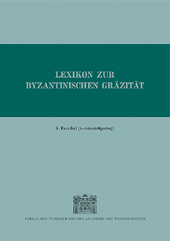

Mit dem vorliegenden 5. Faszikel beginnt zugleich der zweite Band des Lexikons zur byzantinischen Gräzität (LBG). Er enthält alle Lemmata, die mit Lambda, My, Ny, Xi und Omikron beginnen, sowie bereits einige mit Pi. Damit erreicht er eine besondere Vielfalt, die sich unter anderem in einer überdurchschnittlich großen Zahl von Fremdwörtern dokumentiert, die aus dem Lateinischen stammen (besonders unter Omikron). Selbstverständlich findet sich auch in diesem Faszikel eine stattliche Reihe typischer byzantinischer Komposita, beginnend mit leuko-, makro-, mikro-, neo-, xantho-, urano- usw.
Seit der Bearbeitung des letzten Faszikels wuchs die Zahl der Editionen weiter an, die neu eingearbeitet werden mussten. Des weiteren erfolgte eine konsequentere Berücksichtigung sinnvoller Varianten aus den kritischen Apparaten, wie dem zur Chronik des Konstantin Manasses. Was das neu durchgesehene Material betrifft, so legt das beigefügte Ergänzungsblatt der Abkürzungen (ca. 100 neue) davon nur unvollkommen Zeugnis ab. Weiteren Zuwachs an Einzelzitaten, die nur suo loco angezeigt werden, brachten dann vor allem die elektronischen Medien, insbesondere natürlich der „Thesaurus Linguae Graecae“ (TLG), dessen Vergleichung in steigendem Maße mit der jeweils aktuellen Internetversion erfolgt. Darüber hinaus wurde eine verstärkte Berücksichtigung der frühbyzantinischen Papyri vorgenommen, und zwar nach den einschlägigen Wörterbüchern, der CD des Packard-Humanities-Institute sowie der Papyrus-Ergänzungsliste von Hagedorn.
…
The now-published fifth fascicle of the Lexikon zur byzantinischen Gräzität (LGB) also marks the publication of the second volume. It includes all entries beginning with lambda, my, ny, xi and omicron, as well as a few beginning with pi. Thus, it shows distinct diversity, manifested in the remarkably large number of foreign words, mostly of Latin origin. In addition, one finds an imposing number of typically Byzantine compounds beginning with leuko-, makro-, mikro-, neo-, xantho-, urano- and so on. Since the publication of the fourth fascicle, the number of new editions that must be considered has constantly increased. Furthermore, a more thorough consideration of useful variants from the apparatus critici (for example, from the chronicle of Konstantin Manasses) was undertaken. Concerning new material, the enclosed supplement to the list of abbreviations (with ca. 100 new entries) is as yet incomplete. The increase of individual quotations, which are displayed only suo loco, is above all the result of the use of electronic data, especially the online version of the Thesaurus lingae graecae (TLG). In addition, early Byzantine papyri have been taken into account to a greater degree by referring to relevant dictionaries, the CD-ROM of the Packard Humanities Institute, as well as the supplementary list of papyri by Hagedorn.
2005,
978-3-7001-3344-5
978-3-7001-9250-3
280 Seiten + 8 Seiten Beiheft,
29,7x21 cm,